Imagine Kathy Fields walking down Sunset Boulevard in her high heels, with her husband Doug and their friends. They’re all wearing cool 1970s outfits, catching everyone’s eye. Kathy’s bohemian dress and heels show off the era’s style perfectly. Young, trendy models even notice and admire their true 60s style.
This scene made me think about the big fashion change in the 1960s and 70s. It was a time when fashion rules were broken, and expressing oneself was key. Vogue said, “There are no rules in the fashion game now,” as cheap synthetic clothes became popular1.
Fashion went from mod to bohemian in a big way. Mini skirts, bell-bottoms, and vintage clothes became common. Glam rock and disco brought in platform shoes, bright colors, and glitter1. It was all about making bold fashion statements.
Icons like Twiggy and Mary Quant led the mod movement. Designers like Yves Saint Laurent and Halston supported women’s rights and youth culture1. The fashion world was changing fast, and everyone was welcome to join in.
Key Takeaways
- The 1960s-70s saw a dramatic shift from conservative to bold fashion
- Mod and bohemian styles defined the era’s fashion revolution
- Designers and icons played a crucial role in shaping trends
- Synthetic materials and mass production changed the fashion landscape
- Self-expression and individuality became central to fashion choices
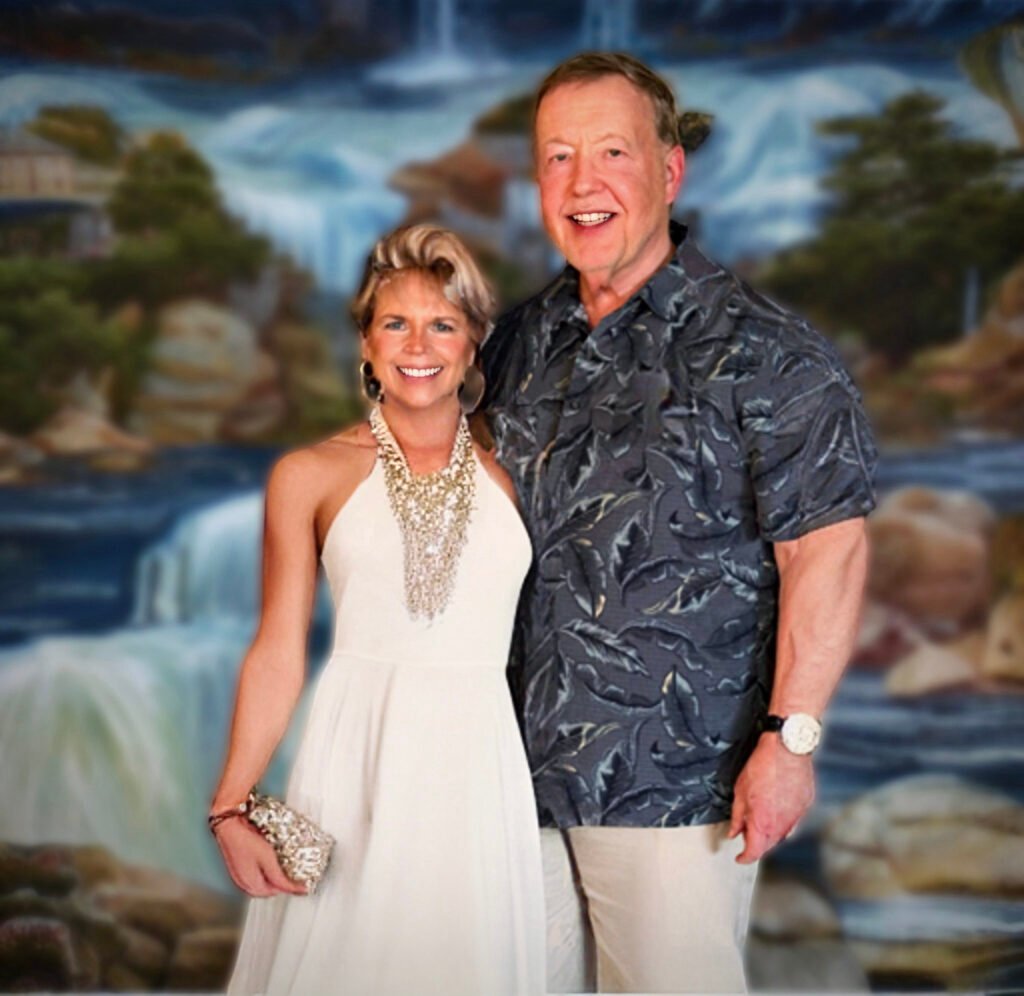
Your host and hostess , Doug and Kathy Fields
Introduction to the Fashion Revolution
I’ve always been drawn to the fashion of the 1960s and 1970s. This time was a big change, moving from strict styles to more personal fashion. The mid-1960s brought a big change from the styles after World War II. Younger, less formal styles became popular, showing the big social changes in the U.S2.
Fashion icons like Twiggy and Mary Quant led the mod movement. They brought bold shapes, colors, and short “mini” dresses into fashion. These trends showed a big change in what was accepted in society2. The British Invasion also played a big part, bringing the mod look to the world.
The counterculture movement pushed for fashion that stood against the norm. This led to more casual, earth-toned clothes and styles for both men and women as a way to make a statement2. The 1970s kept going with fashion that didn’t follow the rules. Bright colors, flower patterns, tie-dye, and ethnic styles became popular2.
In the 1970s, disco fashion came into the spotlight. It brought shiny fabrics, bright colors, and tight clothes to the dance floors2. Designers like Yves Saint Laurent and Halston were influenced by the growing women’s rights and youth culture.
The fashion revolution didn’t end in the 1970s. The 1980s brought even more experimentation to fashion. Icons like Madonna and Cyndi Lauper made a mark with their unique outfits, bold colors, and fun patterns. This era celebrated being different and expressing oneself through fashion.
The Rise of Mod Fashion in the 1960s
The 1960s were a big change for fashion, moving away from the old styles of the 1950s and embracing the new youth culture3. Young people’s earnings went up, giving them more money and a fresh identity4. This led to a fashion revolution that changed trends for years to come.
Geometric Prints and Miniskirts Define the Mod Look
Mod fashion made its mark in the early 1960s, led by young, stylish Brits looking for new styles3. The look was all about sharp suits, bold prints, and bright colors. Clean lines and new materials were key to this bold style3.
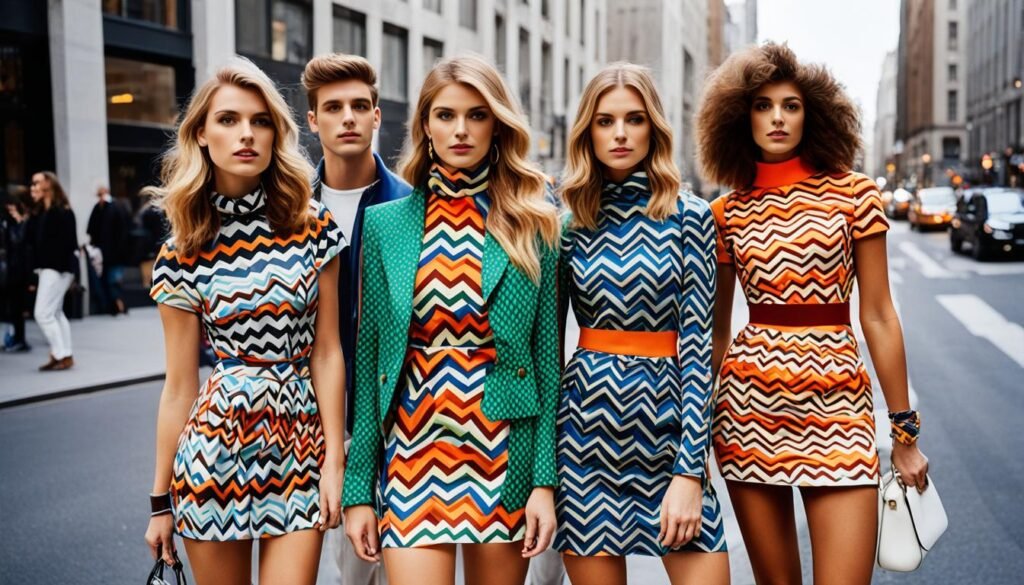
Mary Quant made the miniskirt a symbol of the decade4. This bold skirt showed women’s power and freedom, shaking off old ideas of being feminine3. Go-go boots and miniskirts together captured the young, lively spirit of the time.
Twiggy and Mary Quant: Icons of the Mod Movement
Twiggy’s style was huge. Her short hair and big eyes made her the mod fashion icon. Mary Quant and mod fashion became one, with her shop in London’s King’s Road at the heart of it all4.
Designers like John Stephen and Colin McGurie also shaped the mod look3. Their designs brought a modern style that valued being different and expressing oneself. This set the stage for today’s diverse fashion scene3.
Mod fashion’s influence is still felt today. Its bold prints, bright colors, and new designs keep inspiring fashion now. It shows that true style always stays in style.
The Influence of the Space Race on 1960s Fashion
The space race of the 1960s had a big impact on fashion. It brought futuristic trends that showed our excitement for space exploration. Designers like André Courrèges introduced the “space look” in spring 1964. This included trouser suits, goggles, box-shaped dresses, and go-go boots5.
In the mid-1960s, space-age fashion became more popular. Synthetic materials and futuristic designs were everywhere6. Young people started wearing metallic and neon colors, inspired by the space race7.
Paco Rabanne made a big splash with his 1966 collection “12 Unwearable Dresses in Contemporary Materials.” These avant-garde pieces used chain mail, aluminum, and plastic. They showed what space age fashion could be5. Transparent fabrics and revealing cuts became popular, showing a new kind of freedom in style6.
| Designer | Contribution to Space Age Fashion | Iconic Elements |
|---|---|---|
| André Courrèges | Introduced the “space look” | Trouser suits, goggles, box-shaped dresses, go-go boots |
| Paco Rabanne | “12 Unwearable Dresses” collection | Chain mail, aluminum, plastic materials |
| Mary Quant | Popularized the miniskirt | Short skirts, youthful designs |
The 1960s also changed fashion in hairstyles and accessories. The Dolly Girl look, with models like Twiggy, showed a new beauty ideal. It was young, slender, and androgynous6.
This era of futuristic fashion changed how people showed themselves through clothes. It showed the optimism and tech progress of the time. It changed fashion forever.
Hippie Fashion: Psychedelic Prints and Earth Tones
The late 1960s brought a big change in fashion, moving from the mod style to hippie. This era was all about vibrant colors, bold patterns, and a carefree spirit. Hippie fashion trends included psychedelic prints, ethnic-inspired looks, bell-bottoms, and fringe.

Psychedelic prints became a big deal, showing the influence of rock n’ roll and the counterculture. These prints had swirling patterns and bright colors, inspired by psychedelic rock posters8. Wes Wilson and Victor Moscoso were key in creating this look, with Wilson’s iconic font and Moscoso’s vibrant colors.
Ethnic-Inspired Designs and Bell-Bottoms
Ethnic-inspired fashion was big in hippie style. Items like Indian Kaftans, headbands, and love beads were popular and showed a love for global cultures9. Bell-bottoms, with their wide legs, became a symbol of the era’s free spirit.
Earth tones like browns, olive greens, and rusty reds became popular in hippie fashion10. This change matched the growing interest in nature and the environment.
Fringe became a big trend, decorating jackets, vests, and bags10. This added a fun, textured look to outfits. The late 1960s saw a rise in colorful patterns and earthy colors, making suede fringe vests very popular.
The Summer of Love in 1967 was a key moment for hippie fashion8. Almost 100,000 young people came together in San Francisco’s Haight Ashbury, showing off their psychedelic style. This event made hippie fashion a big deal.
Hippie fashion was more than just clothes; it was a way to express beliefs and values. It was about standing out and celebrating being different. Today, many fashion trends still draw inspiration from this bold era.
The Bohemian Style of the 1970s
The 1970s brought a big change in fashion with bohemian style, also known as ‘Boho chic’11. This style was all about being different and free-spirited. It took inspiration from around the world, focusing on natural fabrics and handmade accessories.
Fringe and Earth Tones
Fringe and earth tones were big in bohemian fashion. Clothes were made of flowing fabrics in bright colors and natural materials11. These choices showed a wish for being unique and standing out from the crowd.
Flared Trousers
Flared trousers were a key part of 1970s bohemian style. They were part of a move towards practical and less strict clothes, influenced by the Rational Dress Society of 188111. Flared pants became popular with disco, which was all about expressing yourself and exploring gender roles12.
| Bohemian Fashion Element | Characteristics | Influence |
|---|---|---|
| Fringe | Added movement and texture | Native American and hippie culture |
| Earth Tones | Natural, muted colors | Connection to nature and simplicity |
| Flared Trousers | Wide-legged, bell-bottom style | Comfort and freedom of movement |
The 1970s bohemian style was a new take on the hippie movement with a touch of sophistication. It celebrated being unique and creative, paving the way for future fashion trends. Designers like Yves Saint Laurent made history in 1978 by featuring the first black woman in a haute couture show12.
Transition from 1960s Conservatism to Mod Fashion and Style of the 1970s
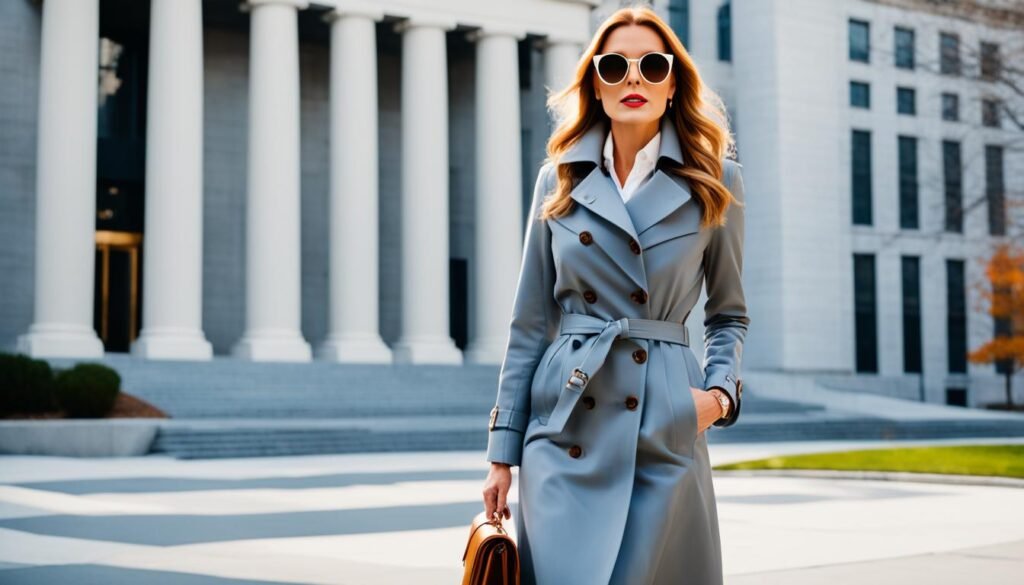
The 1960s brought a big change in fashion. The move from 1960s traditional styles to the mod fashion of the 1970s was huge. Designers like Mary Quant made the mini-skirt popular, showing a big change with the help of new birth control13. This led to women wearing shorter skirts as a way to show they were breaking free from old rules.
The mod style started in the late 1950s but really took off in the 1960s14. It was all about clean lines, bright colors, and bold patterns. New materials like PVC and spandex became popular, showing off the era’s love for the future13.
As the 1960s went on, fashion got even more dramatic. Flared pants became popular for both men and women, leading to the bohemian look of the 1970s13. This change was also influenced by styles from India and Japan, adding a new twist to mod fashion.
“Fashion is not something that exists in dresses only. Fashion is in the sky, in the street, fashion has to do with ideas, the way we live, what is happening.” – Coco Chanel
The impact of this change is still felt today. Modern designers look to the 60s for inspiration, bringing back bold patterns and tailored looks14. The mini skirt and dramatic makeup from that time are still in style today. This shows how the 1960s fashion revolution is still shaping our wardrobes.
| 1960s Conservative Fashion | Mod Fashion | 1970s Style |
|---|---|---|
| Tailored suits | Mini skirts | Flared trousers |
| Natural fabrics | PVC and synthetic materials | Natural fibers and denim |
| Muted colors | Bright, bold hues | Earth tones |
| Pillbox hats | Geometric patterns | Floppy hats |
Glam Rock and Disco: Bold Fashion Statements
The 1970s brought a new era of fashion, mixing glam rock and disco trends. This decade moved from earthy styles to bold self-expression15.
Glitter, Platform Shoes, and Vibrant Colors
Glam rock fashion added a touch of drama to everyday clothes. It brought glitter, satin, and metallics into the spotlight. Platform shoes became key, adding height and drama to outfits15.
Disco fashion trends used bright colors to light up the dance floor. Bell-bottoms, once for hippies, became a disco staple, often matched with shiny tops15.
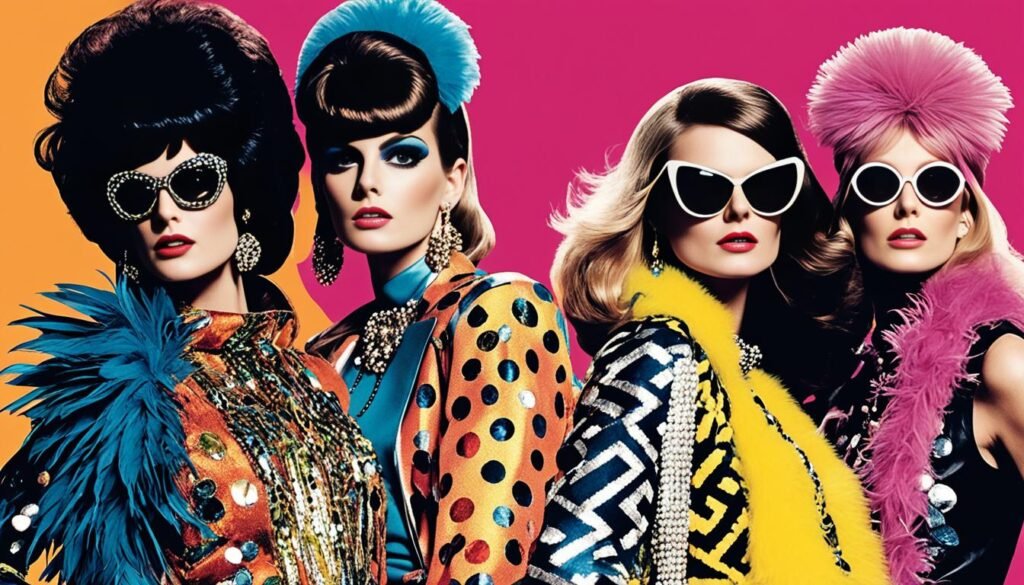
Music greatly influenced fashion back then. Stars like David Bowie and ABBA made the era’s look bold and glamorous. They inspired fans to try out daring styles.
| Glam Rock Fashion | Disco Fashion Trends |
|---|---|
| Glitter and sequins | Satin and spandex |
| Androgynous looks | Figure-hugging silhouettes |
| Platform boots | High-heeled dancing shoes |
| Metallic makeup | Colorful eyeshadow |
This fashion era challenged traditional gender norms. Men and women both wore bold styles. The fashion world became more creative, producing looks that still influence designers today.
The Role of Television and Movies
Television and cinema were key in shaping fashion in the 1960s and 1970s. TV had a big effect on fashion, bringing new styles to millions in America. Movies also played a big role, starting trends that quickly spread.
Fashion Trends Shaped by Popular Shows and Films
Hollywood’s fashion impact was huge during this time. The “Peacock Revolution” in the 1960s brought bold colors and big patterns to screens big and small16. Shows like “The Mod Squad” and “Rowan & Martin’s Laugh-In” showed off the decade’s vibrant, unique styles.

Movies also set fashion trends. “Bonnie and Clyde” (1967) made the beret and pencil skirt popular, while “Easy Rider” (1969) made leather jackets and bandanas a must-have. Teens spent $3.5 billion on clothes in 1965, showing their big spending power17.
By the late 1960s, FM radio became the go-to for rock and roll music, affecting fashion through album covers and live shows18. This change in music taste boosted Hollywood’s fashion influence, linking entertainment and style closely together.
In the 1970s, this trend kept going. Shows like “Charlie’s Angels” made wide-collar shirts and high-waisted jeans popular. Movies like “Saturday Night Fever” (1977) started a disco fashion wave. TV also influenced hairstyles and accessories, not just clothes.
The Democratization of Fashion
The 1960s and 1970s changed fashion forever with a revolution. Ready-to-wear fashion made stylish clothes for everyone. This shift marked a big change, moving away from high-end fashion.
In London, boutiques like Biba and Granny Takes a Trip led the way. They used mass-produced clothes to start new trends19. Thanks to the British government’s support for college education, young creatives from all backgrounds could enter fashion19.
André Courrèges introduced the miniskirt in 1964, and Mary Quant made it popular20. Bell-bottoms and animal prints went from being for a few to being for everyone, showing how fashion was becoming more accessible20.

In the 1970s, polyester became common, making clothes cheaper21. This era was all about expressing yourself and being different. Stars like Mick Jagger and Jack Nicholson became fashion icons, inspiring people everywhere21.
The ‘bubble-up’ theory came to life, where street fashion influenced high fashion. This change has made fashion more democratic and open to everyone today.
| Decade | Key Fashion Trends | Impact on Democratization |
|---|---|---|
| 1960s | Miniskirts, Go-go boots, Psychedelic prints | Introduction of affordable, trendy boutiques |
| 1970s | Bell-bottoms, Polyester fabrics, Bold prints | Rise of ready-to-wear fashion, Celebrity influence |
Youth Culture and the Fashion Revolution
The 1960s and 1970s were big years for youth culture, starting a fashion revolution. Young people wanted to express themselves and challenge old-fashioned values with their style.
Counterculture Movements and Style Icons
The 1969 Woodstock Music Festival was a key moment for the counterculture movement, bringing together over 400,000 people22. Twiggy became a style icon, representing the swinging sixties with her mod style23.
Fashion was a way to protest and express views during the civil rights movement23. In 1967, the Summer of Love drew young people to San Francisco’s Haight-Ashbury. They wore bohemian chic, with flowing clothes and ethnic prints2223.
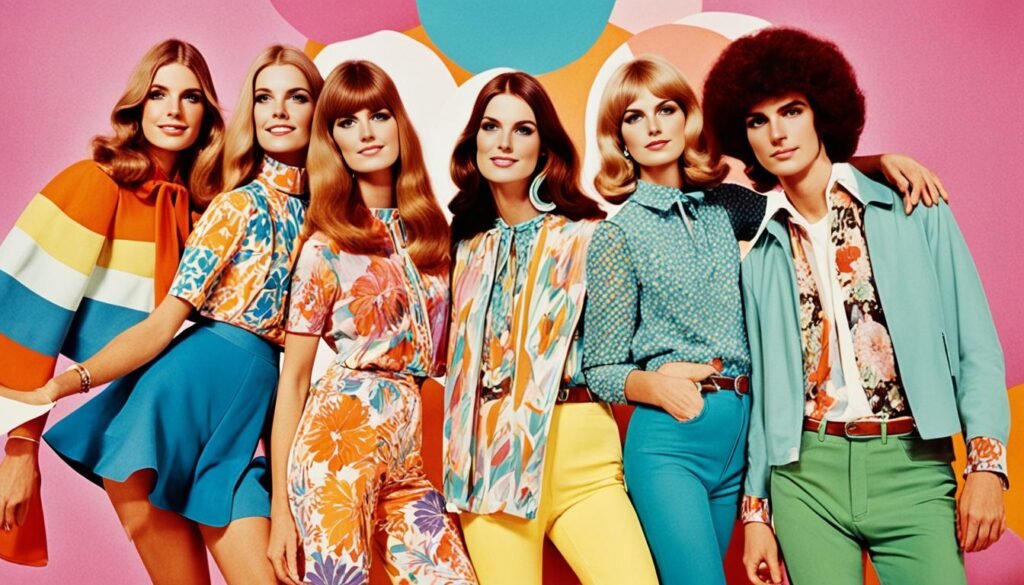
The fashion scene changed because of cultural and political shifts. The 26th Amendment in 1971 let 18-year-olds vote, giving them more power24. This made young people’s fashion choices a way to show their beliefs.
Mary Quant led the mod fashion trend with her bold patterns and mini skirts23. Yves Saint Laurent mixed high fashion with street style, challenging traditional clothing rules23.
Today, the fashion revolution’s spirit lives on. Mini skirts and bold patterns still shape our style, showing how youth culture keeps influencing fashion and self-expression23.
The Impact of Music Festivals and Concerts

Music festivals and concerts were key in shaping fashion in the 1960s and 1970s. These events mixed different styles, affecting mainstream fashion and counterculture. Woodstock in 1969 was a major moment in fashion and music history.
Woodstock fashion was all about being free-spirited. People wore fringed vests, tie-dye shirts, and bell-bottom jeans. This look would shape fashion for many years. The festival brought together hippie and bohemian styles, making flower crowns, headbands, and long dresses popular.
Concert style changed fast during this time. With more money, young people could show off their style. This led to the rise of boutique scenes in cities like London, where affordable fashion became a big deal25.
Fashion and music festivals became closely linked. Artists and fans wore bold, expressive outfits. Men and women had longer hair and wore flared pants, shopping together in boutiques. This change was part of the counterculture movement, which started in the U.S. and spread worldwide26.
These events had a big impact on fashion. They showed off new trends and paved the way for future styles. The relaxed and experimental styles seen at festivals still influence concert fashion today. This shows the lasting effect of this era on style and music.
Vintage Fashion and Retro Trends
I’ve always been drawn to the vintage fashion comeback. The 60s and 70s styles are back in a big way. You see retro fashion everywhere, from high fashion to everyday looks.
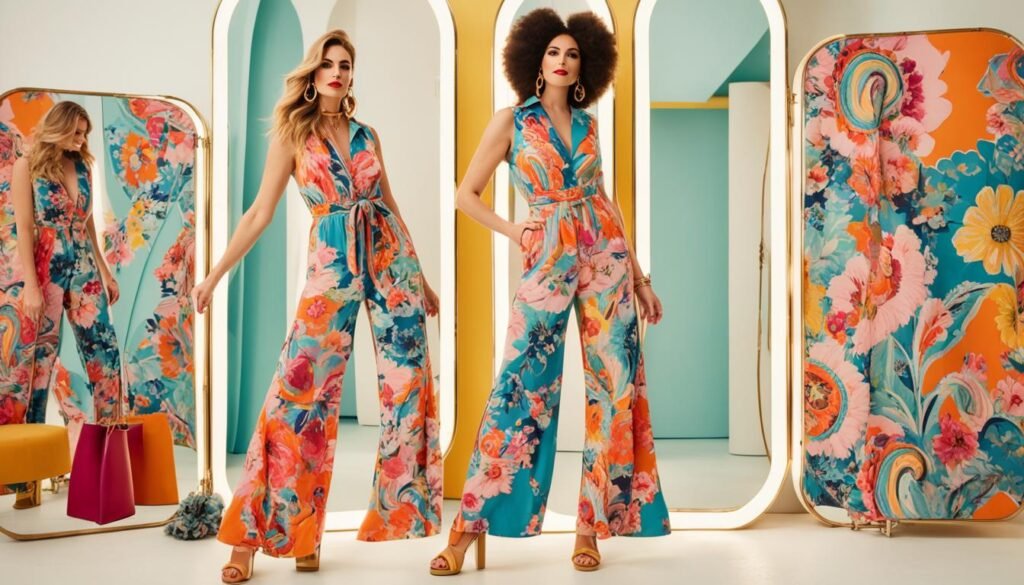
The Revival of 1960s and 1970s Styles
The 1960s mod scene was all about style and being unique. It left a big mark on fashion27. Now, vintage 1960s mod shift dresses go for about €190. Psychedelic tunic dresses from then sell for around €21028. These items show off the era’s lively spirit and still influence today’s fashion.
Cut-outs started in 1965 and are back in style. Designers like Rudi Gernreich were known for their bold cut-out looks. They used vinyl or see-through plastic27. This trend has been updated for today, proving the lasting charm of 60s fashion.
The 1970s bohemian style is also making a comeback. Vintage wedding dresses from then, with deep necklines and flowing looks, can go for up to €79028. These dresses show how much people love 70s fashion.
Fashion trends coming back isn’t new. It’s been happening since the French Revolution29. The late 1960s and early 1970s brought big changes to fashion, like embracing vintage looks29. This shift helped lead to the vintage fashion comeback we see now.
Now, fashion changes fast, with designers often drawing from past styles29. This cycle of bringing back and updating old styles keeps vintage fashion alive and interesting. It ensures the 60s and 70s continue to excite fashion lovers of all ages.
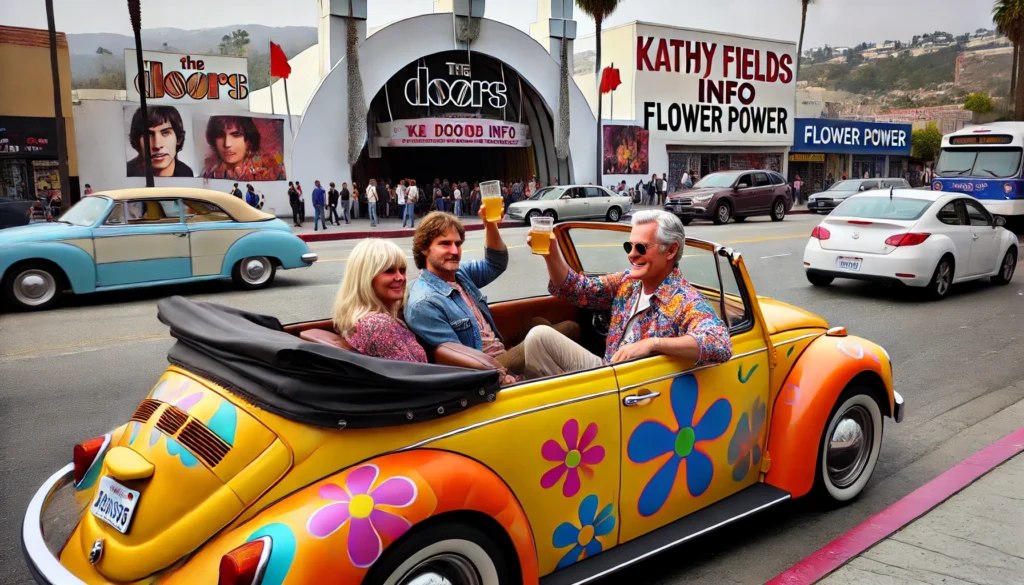
Doug and Kathy Fields, enjoying a late 60s vibe on Sunset Blvd in their psychedelic VW convertible.
The Impact of Media on Fashion Trends: Television shows, movies, and music influencing fashion
I’ve seen how media has changed our style choices. The 1960s and 70s were big for fashion, thanks to TV, film, and music. Shows like All In the Family and The Mary Tyler Moore Show made a big impact, changing what we wear24.
Music had a huge effect on fashion too. Rock ‘n’ roll and hippie culture made tie-dyed shirts and bell-bottom jeans popular30. Concerts and festivals became places to see the latest fashion trends, like psychedelic prints and comfy, flowing clothes.
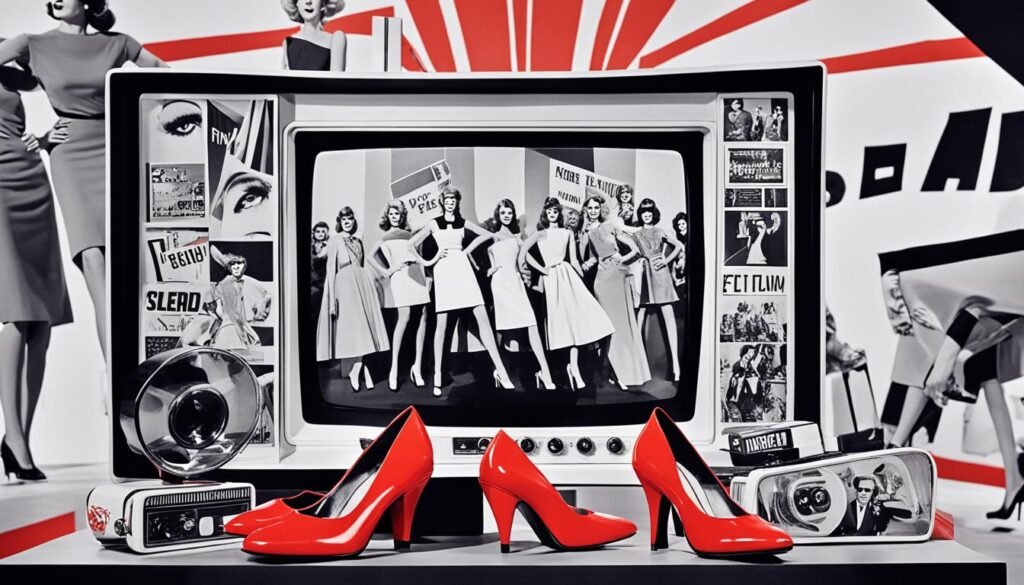
Movies also played a big part. Hits like Star Wars and Saturday Night Fever set new fashion trends24. Even the space race influenced fashion, with designers like André Courrèges creating the “space look” in 196430.
Fashion magazines and ads helped spread these trends further. The miniskirt, made famous by Mary Quant, became a symbol of youth and rebellion30. This era showed how media can really shape our fashion choices, a trend that still affects us today.
Conclusion: The Lasting Legacy of the Fashion Revolution
The 1960s and 1970s fashion revolution changed our style and culture forever. It moved us towards expressing ourselves more, challenging old norms, and setting new trends. Over 90% of women in the 1960s wore bold styles that showed a move towards freedom and being unique31.
Mary Quant made the mini skirt a symbol of women’s empowerment and freedom31. Shift dresses offered a new way to dress, with their simple shapes and bold patterns32. These styles changed not just how we looked but also how we saw ourselves and the world.
The hippie movement brought new life to fashion. It introduced styles like tie-dye, flower crowns, and maxi dresses3233. These styles, along with the use of natural materials, became popular in fashion33. Today, designers still draw inspiration from these groundbreaking trends.
Looking back, the impact of 60s and 70s fashion is huge. It was more than just clothes; it was a shift in how we think. From psychedelic prints to bell-bottom jeans, these styles keep coming back, showing the lasting power of this era.
FAQ
What characterized mod fashion in the 1960s?
How did the space race influence 1960s fashion?
What were the key elements of hippie fashion?
What defined bohemian style in the 1970s?
How did glam rock and disco fashion stand out?
What role did television and movies play in shaping fashion trends?
How did fashion become more accessible during this period?
How did youth culture and counterculture influence fashion?
What impact did music festivals have on fashion?
How has the fashion revolution of the 1960s and 1970s influenced contemporary styles?
What role did media play in disseminating fashion trends during this period?
Source Links
- 1970s in fashion – https://en.wikipedia.org/wiki/1970s_in_fashion
- History: Second Wave Feminism and its Fashion (Rough Draft) – https://medium.com/@8360866/history-second-wave-feminism-and-its-fashion-bacd2f0a463b
- The Bold and Innovative Legacy of 1960s Fashion: An Overview of Mod Clothing, Mini Skirts, Pop Art, and More – Dust Factory Vintage – https://dustfactoryvintage.com/the-bold-and-innovative-legacy-of-1960s-fashion-an-overview-of-mod-clothing-mini-skirts-pop-art-and-more/
- An introduction to 1960s fashion · V&A – https://www.vam.ac.uk/articles/an-introduction-to-1960s-fashion
- 1960s in fashion – https://en.wikipedia.org/wiki/1960s_in_fashion
- Fashion of the 1960s – https://wunderlabel.com/lab/fashion-trends/1960s/
- 4) Fashion – https://macahe.wordpress.com/4-fashion/
- Psychedelic 60s – https://visualartsdepartment.wordpress.com/psychedelic-60s/
- Fashion in the 60, 70 & 80 – https://www.slideshare.net/slideshow/fashion-in-the-60-70-80/48229001
- 1960s Style Clothing & 60s Fashion – https://vintagedancer.com/1960s/
- Bohemian style – https://en.wikipedia.org/wiki/Bohemian_style
- The 1960s-1970s: An Exploration of Androgyny in Men’s Fashion – https://kayleighmargaret.medium.com/the-1960s-1970s-an-exploration-of-androgyny-in-mens-fashion-b305588d8586
- The swinging sixties: Fashion History 1960 – 1970 – Isabella Josie – https://isabellajosie.com/the-swinging-sixties-fashion-history-1960-1970/
- The History of the 1960’s Mod Style – https://fashionpastforward.com/2024/06/24/the-history-of-the-1960s-mod-style/
- A Quick Look at Women’s Fashion in the 20th Century – https://www.wardrobeshop.com/blogs/vintage-style-fashion/a-quick-look-at-women-s-fashion-in-the-20th-century
- What Men REALLY Wore In The 1960s | Gentleman’s Gazette – https://www.gentlemansgazette.com/what-men-wore-1960s/
- 1960s to present_day_fashion_history – https://www.slideshare.net/slideshow/1960s-to-presentdayfashionhistory/21160924
- Counterculture of the 1960s – https://encyclopedia.pub/entry/31169
- 1960s Swinging London & Boutique Fashion – https://iandrummondvintage.com/blogs/fashion-history/1960s-london-boutique-fashion
- 10 Ways the 1960s Invented Today’s Fashion Trends – https://sammydvintage.com/vintage-style/60s/fashion-in-the-1960s/
- Groovin’ To The Late 1960s-1970s – https://alittlebitofrest.com/2020/06/14/groovin-to-the-late-1960s-1970s/
- Youth Culture of the 1960s – APUSH Study Guide 2024 | Fiveable – https://library.fiveable.me/apush/unit-8/youth-culture-1960s/study-guide/RaRE6JHkpeGMR7exEexk
- 1960s Fashion: Allocate the Dynamic Beauty and Retro Fashions – https://medium.com/@gobottega/1960s-fashion-allocate-the-dynamic-beauty-and-retro-fashions-d8d314d43fb4
- The 1970s ‑ Fashion, Events & Facts | HISTORY – https://www.history.com/topics/1970s/1970s-1
- An introduction to 1960s fashion · V&A – https://www.vam.ac.uk/articles/an-introduction-to-1960s-fashion?srsltid=AfmBOopSwSfQY9HolWHavrh6L2MZBgYjFI1ltRzqr-PYra_YvFV62AB3
- The Counterculture – https://thehistoryofrockandroll.net/the-counterculture/
- Trends of the Mid 1960s – Vintage Fashion Guild – https://vintagefashionguild.org/blog/trends-of-the-mid-1960s/
- Which era is for you? Part 3: 1960’s and 1970’s – https://dirtyfabulous.blogspot.com/2014/03/which-era-is-for-you-part-3-1960s-and.html
- Comments About Vintage Fashion and Fashion Revivals – https://costumes.org/2020/09/02/comments-about-vintage-fashion-and-fashion-revivals/
- History of fashion 1950 s to 1970’s – https://www.slideshare.net/slideshow/history-of-fashion-1950-s-to-1970s/57891538
- how did women dress in the 60s | Coveti – https://coveti.com/how-did-women-dress-in-the-60s-4/
- 1960s Fashion – The Ultimate Guide | My Vintage – https://www.myvintage.uk/ultimate-guide-to-1960s-fashion
- Fashion Flashback: Revealing the Impact of 60s Hippie Clothing on Today’s Trends – https://endless-summer-nz.com/blogs/endless-magazin/revealing-the-impact-of-hippie-clothing

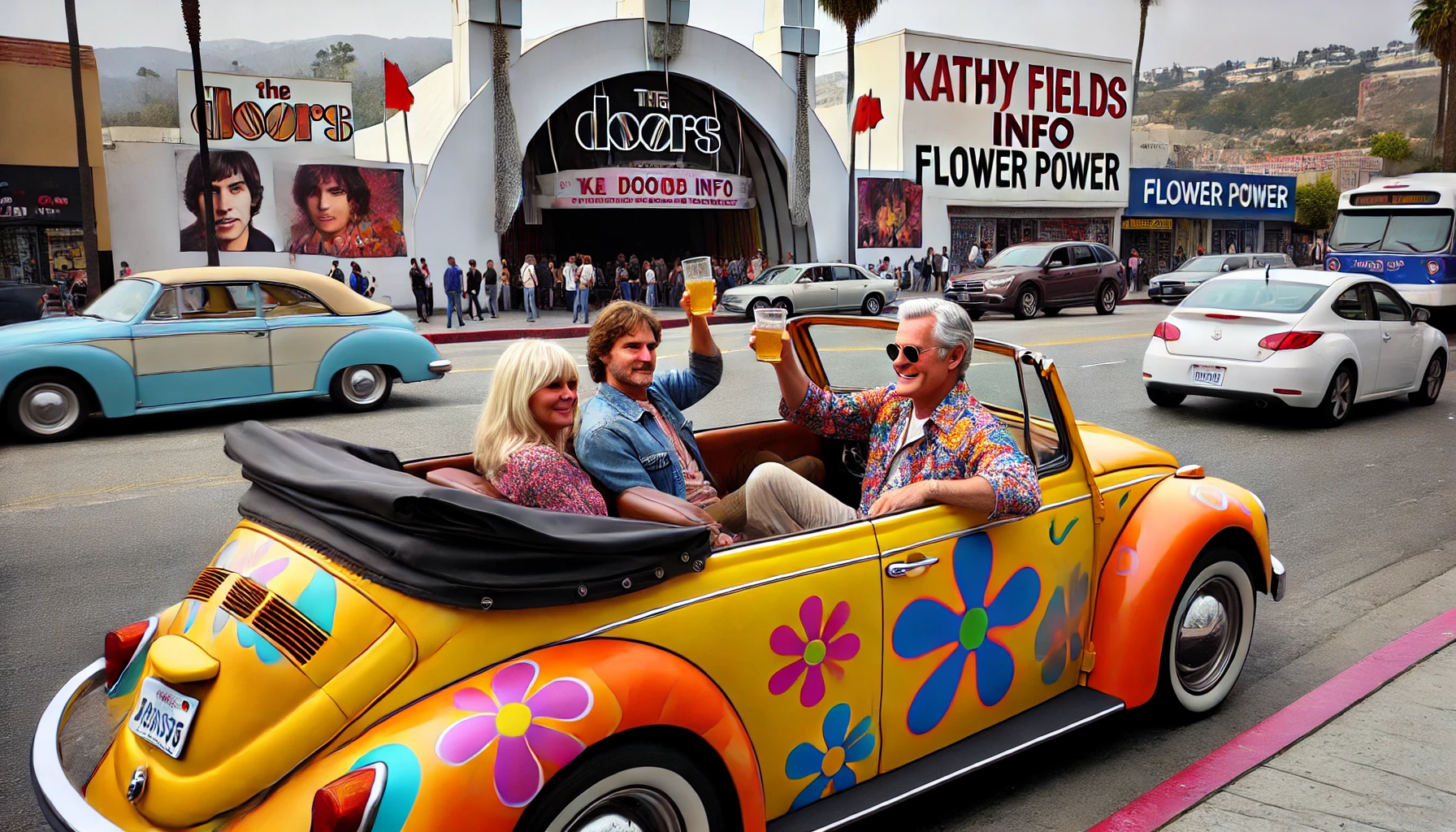

Love it! I was shopping and all of the fall casual clothes ring of the 60’s. Time to revisit the Sunset Strip or London!
Thank you!
Thanks Kathy,
Its great to have “Mind Blowing Colors” again.
Suggestions?
Danelle Carol
Your welcome
Thank you, Kohls, TJMaxx are embracing the 60s, love it
Groovy